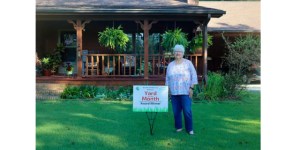Growings On: Fall is the best time to add new trees to the landscape
Published 12:02 am Wednesday, October 16, 2019

- Roger Gates
It’s not Arbor Day, but …
Fall is a great time to plant trees and shrubs.
Trending
Warming temperatures and increasing day length mark the transition from winter to spring. Such conditions naturally prompt thoughts of planting. For many garden vegetables, that’s perfect.
Arbor Day is the annual spring event that promotes tree planting. The Nebraska governor first officially established the celebration on April 10, 1874. J. Sterling Morton had promoted a day to recognize the importance and value of trees on the prairie landscape. Spring tree planting is appropriate in the Midwest.
In the Southeast, autumn is the optimum time for tree planting, when soil is warm and daytime temperatures are moderate. This year, moderating October temperatures indicate that summer has finally come to an end. Unfortunately, we are still waiting for rain to correct dry soil conditions. Planting can proceed if supplemental watering is possible. If not, it would be prudent to wait for improved moisture before planting.
When correctly sited and planted, a fall-planted tree will perform better than a spring-planted tree because the fall tree will establish roots before the warm summer temperatures draw moisture from and cause stress to the tree.
University of Georgia Cooperative Extension offers these tips to successful tree planting.
• Pick a good tree. Most trees sold commercially for planting will be either bare root, containerized and/or balled and burlapped. Bare-root trees will be available in late winter, while containerized trees are available year-round. Balled and burlapped trees are usually available in late fall to early spring. Optimal planting time for container-grown trees is early to late fall. Balled and burlapped trees are best planted in late fall. Late winter is the best time to plant bare root plants.
Trending
All of these are good options with preexisting root systems because they can latch onto the new soil around them more easily. Research the size and characteristics you want your trees to have before you purchase. UGA Extension offers a guide for trees that flourish in Georgia’s climate, “Landscape Plants for Georgia,” that lists best options for different areas.
Trees like Japanese maples, dogwoods and redbuds are all popular choices in Georgia, but they are not always cared for correctly. Many are planted in direct sunlight, when in fact they are understory plants that need a little reprieve from the sun. Planting shade-loving plants in full sun can stress the plant and lead to disease and insect issues later on. Always look up the attributes of every tree you plant.
• Prepare the right hole. According to the Arbor Day Foundation, the proper hole size depends on the root type — there is no firmly set standard. Many people dig a deeper hole than is necessary.
For bare root plants, to dig a hole a little wider than you think so unkempt roots can grow outwards. You want the rootball or root tops to be at or just above the surface of the surrounding soil for any kind of roots.
With containerized trees, dig a hole that is about three- to four-times wider than the root container. It is necessary that the hole have sides sloping inwards like a bowl for the best root growth.
A bowl-shaped hole should be dug for balled and burlapped plants. The diameter should be is two to three times wider than the root ball and about as deep as the entire root ball. The top of the root ball should not sink below the ground. If the crown is below ground, your hole is too deep. Use additional soil under the root ball to raise the crown level with the rest of the ground. Spread some pine straw or mulch over the planting area (to within an inch of the trunk) to cool the soil and protect the trunk and root system.
• Regular watering is essential. Most people are great about watering their plants right after they plant them, but that isn’t enough. A healthy root system needs regular management to establish itself. New trees usually take around three years to fully establish, and they are quite vulnerable in the first year.
As a rule, landscape plants require an inch of water a week, whether from rain or watering. Trees from containers need a more frequent watering schedule of several times a week, while a balled root system may only need watering once a week.
For more information about how to plant specific tree types, UGA Extension circular 989 covers “Tree Planting Details.”
Roger Gates is the agricultural and natural resources agent for University of Georgia Extension, Whitfield County. Contact him at roger.gates@uga.edu.





